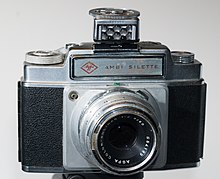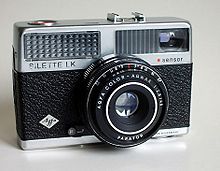Agfa Silets
With Silette called Agfa a small picture - rangefinder camera with a fixed lens and manual exposure setting . The first Silette from 1954 is an independent model, with the appearance of Agfa Optima in 1959, models with manual adjustment were derived from this and again called Silette . With the Silette LK Sensor , the last model appeared in 1969, after which Agfa only released fully automatic and program machines due to a lack of demand.
First generation
prehistory
Around 1952, several 35mm cameras with fixed lenses appeared, whereupon the folding cameras with their bellows went out of fashion and they were regarded as pre-war technology. Basically there was nothing wrong with such a folding mechanism, especially since it actually led to a flatter and therefore more manageable camera. On the other hand, most cameras were carried around the neck with the model-specific leather case, although a few centimeters more thickness did not disturb. Agfa initially did not react to the trend and even brought out a conventional model with the Solinette .
Silets
In 1954 the long-awaited Agfa finally came into being based on the new design principle, the hugely successful Silette . Their daily production was at times 2400 copies and they had, for example, a considerable share in the 62 million DM turnover of the Agfa Camerawerk in Munich in 1955. This camera not only did without the bellows, it also had a quick-release lever, and the shutter lift was coupled with the film transport. Similar to the Isolette, it underwent numerous undocumented detailed modifications in the course of its production time. In addition, they were also available with different lenses and shutters, as was common with practically all manufacturers at the time.
Silette L
The Silette L was the first Agfa camera with a built-in light meter; it went into production in 1955, for which the instrument construction department in the Munich plant was set up, and in 1956 it went on sale. This light meter was housed in a modified housing cap, it was uncoupled, so it had its own setting wheel, and worked - like all electronic light meters of its time - with a selenium cell.
Super silets
The Super Silette , built from 1956, had, like the Super Solinette, a range finder integrated into the housing cap. The Prontor-SVS and the Synchro-Compur lock were optionally available. There was also a choice of the three-lens Agfa Color Apotar, the four-lens Agfa Color Solinar, both 1: 3.5 / 45 mm, or the six-lens Agfa Color Solagon 1: 2.0 / 50 mm in the lens program. Cameras with these “Gauss” lenses were considered a luxury at the time, until they became a mass product from Japan in the 1960s. Their visual superiority contributed decisively to the dismantling of the German supremacy.
Super Silette L
The Super Silette L , a rangefinder camera with uncoupled exposure meter, Prontor-SVS shutter and a four-lens Agfa Color-Solinar 50 mm f / 2.8 built from 1957 with a similar housing to the Silette SL . The price was 249 DM.
Silette LK and Silette SL
The two models LK and SL had a coupled exposure meter, so it was already a semi-automatic machine: if the settings for aperture and time were adjusted on the lens, these were transferred directly to the exposure meter and the correct exposure could be determined with its pointer position.
The main difference between the two models was the lens: the Silette LK had a three-lens lens f / 2.8 with 45 mm focal length of the Agfa Agnar or Agfa Apotar type , the SL the four -lens Agfa Solinar f / 2.8 with 50 mm Focal length . In the SL , the lock was always of the Prontor SVS type , different ones have been installed for the LK .
The Silette SL cost 249 DM.
Ambi-Silets
In the name Ambi-Silette , Ambi referred to interchangeable lenses.
“I don't want more than anything. The distant motif must be close - and that close all around must be fully grasped. And of course all of this in color. First class - of course. "
Agfa offered four different focal lengths for this model:
- Ambion f / 4, 35 mm
- Solinar f / 2.8, 50 mm
- Telinear f / 4, 90 mm
- Color-Telinear f / 4, 130 mm with a separate viewfinder
The lenses were still heavy because they were made of chrome-plated brass, while aluminum was increasingly being used. The camera viewfinder adapted to you with changing bright frames for each focal length and also had an automatic parallax compensation that worked with all lenses. This meant that it would move with the distance setting to compensate for the different field of view of the viewfinder and lens at close range. The flash synchronization took place via a cable contact - in the picture on the left above the lens.
With the 50 mm lens, the camera cost 298 DM, but there was no exposure measurement. However, the range of accessories included attachable exposure meters from various manufacturers.
Second generation
prehistory
In 1957 the first model of a new Silette generation with a plastic housing appeared. Technological progress made it possible to build more complex housing shapes from this material. Above all, this saved production costs because, in contrast to die-cast aluminum, parts of it hardly had to be reworked. So initially a simple silette came out of this material. After 1960 all Silette models got the new housing, which was also used for the Optima Ia and was derived from the plastic housing of the Isoly series.
Around this time, the importance of the Silette changed , it was now mainly important as an entry-level camera at a price for which it was not yet possible to produce complex exposure controls. The previous group of customers is now covered by the Optima with its automatic program, or the Selecta timing machine for more committed photographers .
Silets
The simplest Silette cost 69.50 DM and had the three-lens Agfa Agnar , f / 3.5 with 45 mm as well as the Agfa Vario shutter with times 1 ⁄ 25 s, 1 ⁄ 50 s and 1 ⁄ 200 s.
Silette I
In 1962, the Silette I was introduced as the basic model . With the Silette L , she shared the three-lens Color Agnar lens , f / 2.8 with 45 mm focal length, but in contrast to this, it did not have a built-in exposure meter. The Agfa Prontor shutter could be set to B, 1 ⁄ 30 s, 1 ⁄ 60 s and 1 ⁄ 125 s and had a cable release connection.
Silette L
The Silette L cost 99 DM and had the three-lens Agfa Agnar f / 2.8 with a focal length of 45 mm and a bright line viewfinder. Its Agfa Parator type shutter lasted up to an exposure time of 1 ⁄ 125 s. The Silette L had an uncoupled light meter.
Silette LK
The Silette LK differed from the Silette L in that it had a coupled exposure meter and a shorter exposure time of 1 ⁄ 250 s, but had the same lens.
Third generation
Situation around 1970
While manual exposure control was still important for simpler cameras in the 1960s, this group of buyers ceased to exist around 1970. With increasing prosperity, committed photographers could afford more expensive cameras, especially single-lens reflex cameras . And for those with no technical knowledge, cameras with weather symbols were created to simplify operation. So Agfa derived a Silette from the third generation of the Optima, but it was no longer widely used. From the fourth generation there was no longer a model derived from it, neither one with manual exposure control nor one with automatic aperture control.
Silette LK sensor
The Silette LK sensor largely corresponded to the Optima 200 sensor and was a camera with manual exposure control. Aperture and exposure time had to be set on the lens, for this purpose the pointer of the exposure meter was reflected both in the viewfinder and on top of the housing.
The f-number could be set from 2.8 to 22, the shutter speed series was: B - 1 ⁄ 30 s - 1 ⁄ 60 s - 1 ⁄ 125 s - 1 ⁄ 300 s. The three-lens Agfa Color-Agnar f / 2.8 45 mm was used as the lens. Since there was no automatic flash as with the Optima, the film speed could be set at the bottom of the lens instead of the guide number of the flash unit, the range went from ISO 25/15 ° to ISO 400/27 °. Savings in the compensation of the lens, as can be seen in the picture, led to strong reflections and continued to devalue the camera compared to the Japanese competition.
gallery
Web links
- Agfa Silette in "Christian Zahn's Optics Collection"
- Agfa cameras in the "Lippe Camera Museum"













